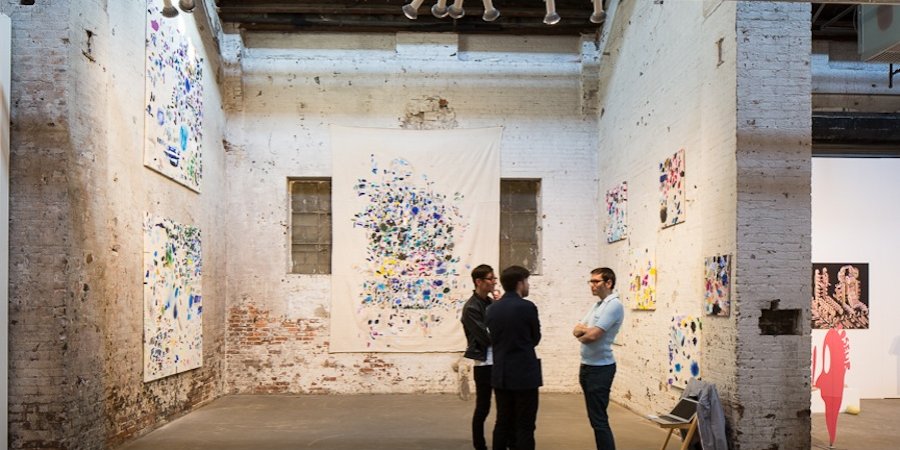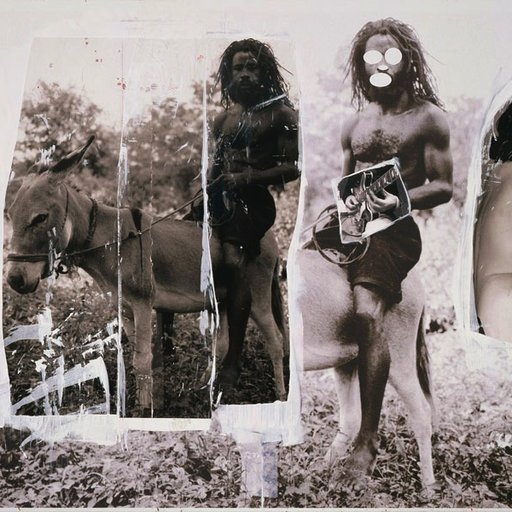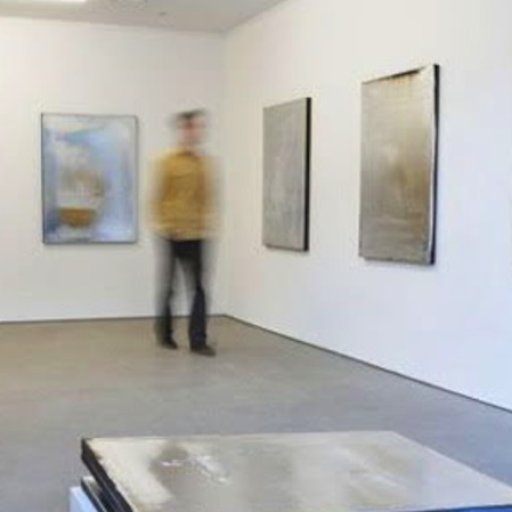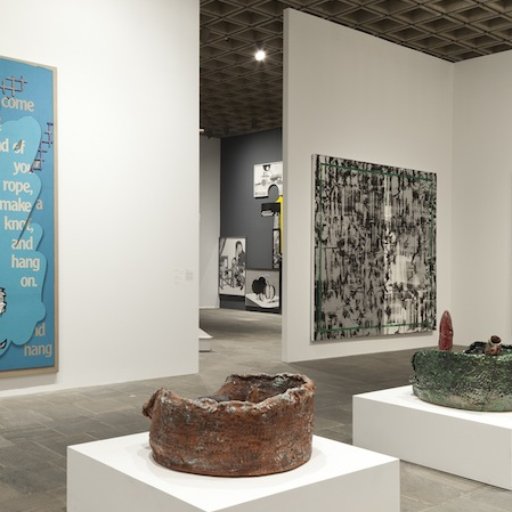The other day, while attending a matinée by way of seeking inspiration for my beloved Artspace column, it occurred to me—and it’s by no means an original idea—that artists are like the X-Men. Possessed of strange powers that are both a blessing and a curse, they are dramatically individual and distinct from each other, but, perhaps more importantly, separate from the vast mass of ordinary people. They are freaks, yes, but freaks with a mission: nothing less than the salvation of all humanity (as I have written before in my column “Why Artists Just Want to Help." This is no simple task, of course, especially when faced by widespread suspicion and even hostility. Considerable effort must be devoted to fostering a cloistered community devoted to their own survival.
Later, out in the Lower East Side sunshine on a Sunday afternoon, I ran into Brian Donnelly—the street artist known as KAWS—with his wife, the artist Julia Chiang, and their new baby girl, while they were taking the air. KAWS is something of a mutant superhero himself, having managed to parlay his skull-and-crossbones "Companion" cartoon character, which I first saw in the 1990s graffitied onto a phone-booth advertisement on Madison Avenue, into a global brand of considerable mass appeal. He’s designed toys, perfume bottles, skateboards, a balloon in the Macy’sThanksgiving Day Parade, the statuette for the MTV Music Awards, and is also, by the way, represented in New York and Paris by Galerie Perrotin.
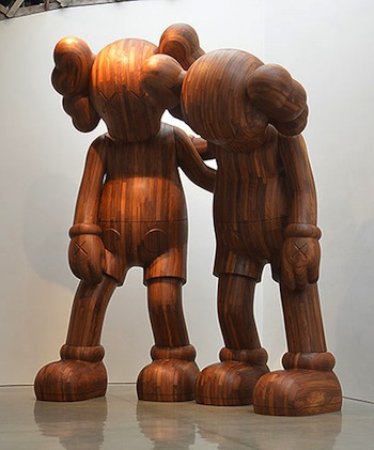 KAWS at Mary Boone
KAWS at Mary Boone
Julia, for her part, works a lot in ceramics. A few years ago she made a show of white ceramic chains for Half Gallery, in an exhibition called “Security Is Mostly a Superstition,” a sentiment with which I’d have to agree. A display in the New Museum window of some raindrop-patterned ceramic vessels, the dark marks spreading across their white surfaces like weather on a globe, has just ended. You could say the new stuff is sort of like a mashup of Storm and Magneto, if you were under the influence of Marvel Comics.
To my astonishment, since I had no idea, Donnelly told me that it was I who had first made it possible for him to quit his day job. For several years I was head of the jury for something called the Pernod Liquid Art Award, a grant that amounted to $15,000 or so, and one year we had given it to KAWS. I had completely forgotten the whole thing, but was happy to play the part of a puppetmaster, even if only for a moment (and retrospectively). Later I remembered it was my East Village co-conspirator Carlo McCormick, who is today the go-to-guy for Street Art and Low-Brow culture, who steered the award to KAWS. So I had appropriated the credit. I remember too that I had put on the jury the art dealer Kenny Schachter, now in London but then over in the far West Village, who disappointed me—I took our jurying duties seriously, though I can’t imagine why—by greeting the slides of every grant candidate with the refrain, "I could sell that!"
 Julia Chiang at the New Museum
Julia Chiang at the New Museum
That’s really enough about KAWS for now, but I can’t resist mentioning another art-world mutant, the art hustler extraordinaire Larry Warsh, who happened to stop by my apartment the next morning. Over the years, the estimable Warsh’s portfolio has included—always early on—graffiti stars like Jean-Michel Basquiat, Keith Haring, and Kenny Scharf, and then the array of artists in the Chinese art boom, and most recently Ai Weiwei, for whom Warsh occasionally acts as producer, promoter, and dealer as well as collector.
When I complained that I needed a topic for my Artspace column—this one—he with no prompting suggested that KAWS was just the thing, saying that he was the next step in a pop genealogy that starts with Andy Warhol and runs on through Jeff Koons. To emphasize his point, he told me that the 18-foot-tall wooden standing figures in KAWS’ show last December at Mary Boone Gallery in Chelsea had sold for maybe almost $1 million each to the rapper Swiss Beatz and the Brooklyn Museum. Now, you may not be able to believe everything Larry says, but he is never wrong.
On Sunday, ever in search of new mutants, I unparked the trusty '98 Ford Escort—hey, what'ss that oddly musical metallic noise?—and ventured out to the Bushwick Open Studios, making my first stop at a new art fair dubbed NEWD. Free to enter, nicely installed in a spacious ground-floor space of one of the neighborhood’s many industrial buildings, NEWD brought together maybe a dozen curatorial efforts from pop-ups to local galleries, which didn’t pay a booth fee but instead committed a percentage of sales up to some modest ceiling (not too many thousands of dollars, I was led to understand).
Participants included Theodore Art from over on Bogart Street, the respected Brooklyn art co-op Regina Rex and a gallery just moved to New York from Portland called American Medium. Individual booths weren’t labeled, oddly, but a large map was drawn on the wall near the entrance. Iced coffee and tea could be purchased. As I arrived, an illustrious panel of four bohemian art-worlders was even holding forth on art’s role in gentrification.
Why “NEWD”? Apparently it’s not an acronym. You must dub your fair with some moniker, and this nonce name does well at suggesting something new, unostentatious, nerdy, comic, contrarily literate and racy.
 Vince Dermody's "Spirit Jug" at NEWD
Vince Dermody's "Spirit Jug" at NEWD
I was delighted to find, in a corner booth by the lavatories, my old pal Vince Dermody, who I first met in 2007 when he gave me a tour of Chicago’s “Uncomfortable Spaces” in his Chevy. Now a Brooklyn artist, Vince was working the fair for a gang of Chicago natives doing business as Law Office, and flogging his own new works, a series of “Spirit Bottles” covered with a clay-like layer of colored cement into which is embedded all manner of little charms, whirligigs, and gewgaws. The tops are sealed with corks, Vince said, to keep the magic in. Readers may know how much I like art that frankly aspires to the condition of magic (see “Can Art Perform Feats of Magic”), and at $1k each, the things are a steal.
 Pedro Velez at NEWD
Pedro Velez at NEWD
Law Office's wares also included a colorful wall painting by Pedro Velez that caustically marks the date—2050—when it is expected that white people will no longer be a majority of the U.S. population, as well as four burlap and gold-leaf abstractions by Rob Davis, another rising art star who has shown at Half Gallery. Velez’s work was already sold, and only two of the Davises were left, so I immediately began negotiating with a young woman in the booth for their purchase, at $4k each, planning to resell them in a year for a 1,000-percent markup. Before I could even pull out my gold card—I was being facetious, I should perhaps mention—she declared that I would have to sign a resale royalty provision entitling the artist to 15 percent of any profit above the purchase price. "I wouldn't bother with that," Vince said. "I'd just make more and sell them at the new price."
The saleslady in question turned out to be Kate Bryan, a 31-year-old veteran of Andrea Rosen Gallery, who had conjured up the NEWD art fair out of the new Bushwick art scene. When I began to interrogate her on the business plan, she blithely waved my questions away. What she envisions, she said (in so many words), wasn’t a single business as much as a constellation of possibilities for collaboration and innovation.
 NEWD organizer Kate Bryan
NEWD organizer Kate Bryan
Is that what it’s all about, or what? In closing, let me note that if artists are mutants, then the art world is a place ruled by what you might call Pollyanna Capitalism: a utopia where anyone with enough gumption or luck or nuttiness can summon their own success out of thin air. The art world is huge—$66 billion a year in the latest estimate, according to Bloomberg arts reporter Katya Kazakina—a reservoir of surplus capital, a place where so much money meets all that excess talent. Everyone wants a piece of it—and they’re getting it. The New York carpenters union wanted a piece of the Frieze Art Fair and they got it. The Yams Collective wanted a piece of the Whitney Biennial, and they got it. The hedgies on Wall Street, the bit-heads in Silicon Valley, the politicians in D.C., the oligarchs in Russia, the Peoples Revolutionary Army in China, they all get their piece. It's all there for the taking, like cyberspace, because when it comes to art, everybody wants some, and there's a limitless supply.
Walter Robinson is an artist and art critic who was a contributor to Art in America (1980-1996) and founding editor of Artnet Magazine (1996-2012). His work has been exhibited at Metro Pictures, Haunch of Venison, Dorian Grey, and other galleries, and he has a new show at Lynch Tham through July 13. He can be reached at walter@artspace.com. Click here to read his previous See Here column on Artspace.











